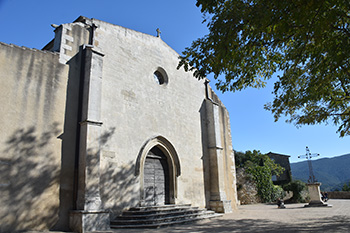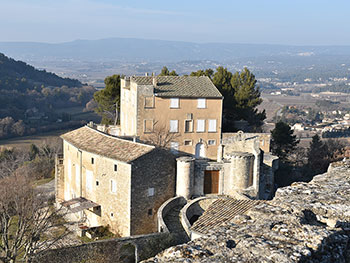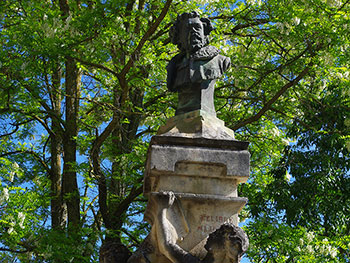Main monuments
The wash house
The Ménerbes wash house was built in 1908, attached to the village's public fountain for watering beasts of burden. It is protected by a roof resting on six square pillars and has two end-to-end basins, lined with wash stones. In the center, the partition that separates the two basins supports an iron ring through which once passed a long cylindrical beam used to place wet, soaped or rinsed laundry. In the past, small fireplaces were used to heat water in washing machines.
 Hotel Girardet de Castelas
Hotel Girardet de Castelas
17th century fortified house belonging to a recently ennobled family from Ménerbes, Girardet de Castelas. Sébastien, first of the name, occupied the function of viguier (judicial officer) in Ménerbes in 1685. Located at the start of the road to Bonnieux, the house was integrated into the Bourgade Saint-Estève created in the 16th century. Across the street, a mansion belonging to Richard Constance channeled visitors to the now missing Elm Gate.
 Dora Maar House
Dora Maar House
This 18th century mansion belonged to Charles-François de Ferres, a descendant of Italian glass masters who settled in Goult in the middle of the 15th century. This residence subsequently belonged to General Robert (1772-1831), an empire baron who covered himself with glory in Tortosa during Napoleon’s wars in Spain. He was appointed governor of this city in 1813. In 1825, for his retirement, he returned to live in his native village, Ménerbes, where he died on June 16, 1831. He is buried in the family vault which is located in the garden of the old Presbytery.
 Hotel de Tingry
Hotel de Tingry
This elegant 18th century residence was built by Joseph Balthazard des Laurents. It has a very beautiful porch and its courtyard was once surrounded by the pebbles of the Durance. The Laurents family, of Piedmontese origin, had settled at the beginning of the 16th century in a mansion, Plan de Lunel, in Avignon. A powerful and influential family from Avignon, they had made the Hôtel de Tingry their country residence. The last heiress was Eléonore Pulchérie des Laurents, wife of Charles François Christian Montmorency-Luxembourg, Prince of Tingry, who gave her name to this mansion.
 The Citadel
The Citadel
The Citadel was built after the siege of Ménerbes (1573-1578, see article on the old prison) to house a garrison of Italian armed men to ensure the permanent protection of the village. The first governor, Francisco Ricciardi, was appointed by Pope Clement VIII in 1594. This arrangement will last until 1791. Two side towers connect the monument to the rampart. A first round tower to the right of the portal is linked to the main body. On the other side, there is a watchtower which completes a circulation gallery and overlooks the street leading to the Portail Neuf (built in 1751 and now disappeared).

Former prison
The prison was integrated into the existing defenses in 1573, the year of the occupation of Ménerbes - a village distinguished by its loyalty to the Pope - by 150 Protestant armed men. As this outrage against the Holy See could not go unpunished, a siege was put under the command of Henri d´Angoulême with around 15,000 cavalrymen and soldiers on foot from Corsica and Italy. Despite this favorable balance of power for the pontificals, the siege lasted five years.
Hotel d’Astier de Montfaucon
This mansion was built to support the remains of the old ramparts. It was built in the 17th century by the Astier de Montfaucon family, Languedoc barons who usually resided in Carpentras. Charming residence inspired by Italian achievements, this second home is decorated with a loggia opening onto an enclosed garden dominating the landscape. In the garden, there is a back-to-back fountain with a sculpted mask and a well, as well as the family coat of arms carved in stone.
 Clock tower and old town hall.
Clock tower and old town hall.
This tower, crowned with a wrought iron campanile surrounded by five crosses, was rebuilt at the end of the 16th century. The mechanism of the clock consisted of a weight system that the incumbent "clock driver" had to wind up. The Clock Tower marks the great moments in municipal life.
Demolition and reconstruction work on the Town House leaning against the tower was completed on January 18, 1768. The complex housed the town hall until 1977.
 The Carmejane
The Carmejane
Located on the site of the old feudal castle of Menerba, whose origins date back to 1081, La Carmejane is a true summary of several centuries of history. Towards the end of the 15th century, it became the home of a large family from Gascony, the Carmejane, who prospered in Ménerbes until the revolution. Joseph-Charles (1772-1830), Empire baron and general, distinguished himself at the Battle of Valmy.
 Saint-Luc church.
Saint-Luc church.
Saint-Luc Church was rebuilt in the 16th century after the Wars of Religion, probably on the site of a priory called Saint-Sauveur, near the old cemetery. The consuls and aldermen met in the square in front of the church. A wrought-iron cross is sealed on a square plinth built, like the church, in white limestone from neighboring quarries.
Saint Sauveur Gate
This defensive work, which bears the old name of the church, was part of the ramparts that protected Ménerbes and was one of the entrances to the village. In the past, the village had other entrances, including the Porte Notre-Dame or “Porte du Midi” demolished in the 19th century.
 The Castelet
The Castelet
The origins of Le Castelet remain unclear to this day. It belonged at the beginning of the 15th century to Raymond Barralier, one of the co-signers of Ménerbes. Subsequently, the building and its land were owned by the Guilhens family, then in 1605 by the family of Italian origin Galléan, established in the 14th century in Avignon and owner of several other seigneuries.
Saint-Blaise Chapel
This chapel, built in 1734 by the brotherhood of white penitents, bears the title of Saint Blaise, patron saint of hemp carders. Great healer and bishop of Sebaste in Armenia, he was martyred during the reign of Diocletian and died in 316.
 Clovis Hugues
Clovis Hugues
Poet, novelist and politician. Son of a miller, Clovis Hugues was born in Ménerbes on November 3, 1851. At the age of 19 he joined the Insurrectionary Commune of Marseille and wrote an article in the Vrai Marseillais which earned him a sentence of three years in prison and a fine of 6,000 francs for press offense.
 Notre Dame des Grâces Chapel.
Notre Dame des Grâces Chapel.
This chapel was rebuilt in 1720 by the Ménerbiens, in thanksgiving for having been spared the plague. It exploits an old site which preserves in its base the remains of an enigmatic building, perhaps an older chapel. It should be noted that nearby was located, also on the outskirts of the current village, the important Saint-Estève priory (5th century) which refers to early Christian times
 Saint-Hilaire Abbey
Saint-Hilaire Abbey
The former Carmelite convent in Ménerbes, built on a steep slope facing the Luberon, is fortunate to have kept its medieval architectural unity (13th century) and its 17th century extension. A community of hermits who took refuge from Mount Carmel in Palestine during the Crusades lived here for five centuries. The Carmelite brothers ensured religious life for the neighboring inhabitants and arranged the terraces for farming.



